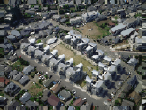“If possible, I hope that through the buildings I design and build, even if they are only a little bit, they can at least make the natural and urban environment better than before.”.


On the evening of March 5th, 2024, the highest honor in the architecture industry, the Pritzker Prize, was announced. The winner was 79 year old Japanese architect Riken Yamamoto..

He is the 53rd recipient of this award and the ninth Japanese architect to receive this honor, following Shin Iwasaki, Sakamoto, Kazuo Mijima, Riwei Nishizawa, Kenzo Tanshita, Fumio Nishikawa, Toyo Ito, and Tadao Ando..

This result is somewhat surprising. Riken Yamamoto is not a well-known “star architect”, and his architecture does not have a distinctive design style..

Rixian Yamamoto’s most well-known works in China are the Beijing Jianwai SOHO, which was built 20 years ago, and the Tianjin Library, which was built 12 years ago..

Riken Yamamoto (Image source: Pritzker Prize official website, photo provided by Tom Welsh).

Alejandro Alavina, winner of the 2016 Pritzker Prize and chairman of the current Pritzker Prize judging committee, praised Riken Yamamoto as follows:.

One of the most important things we need to do in the future city is to create conditions through architecture and increase opportunities for people to gather and interact. Yamamoto has carefully blurred the boundary between the public and private spheres, making positive contributions to community building beyond his scope of responsibility. He is a reassuring architect who makes daily life more dignified; makes routine things extraordinary; and moves life from tranquility to glory. ”.

Riken Yamamoto: From “rebellious youth” to “architects who are not good at design but want to change the world”.

Riken Yamamoto was born in 1945 and grew up in Yokohama, Japan. His mother was a pharmacist. When he was young, the family lived in a house similar to a traditional Japanese town house. There were two spaces in the house: a pharmacy run by his mother and a living area. “One side of the threshold belonged to the family, the other side belonged to the community, and I sat in the middle.”..

Since childhood, Rixian Yamamoto has been seeking a balance between public and private spaces, and has also felt the warmth that the community brings to small families. This is his initial experience of architecture..

Riken Yamamoto and his family during his youth (Image source: Pritzker Prize official website, photo provided by Riken Yamamoto).
His father passed away when he was only 5 years old. He wanted to become an engineer like his father, but his fate changed when he saw the Five Towers of Nara Xingfu Temple. He was attracted by the Five Towers, which symbolized the five Buddhist elements of earth, water, fire, wind, and air, and aspired to become an architect..
Nara Xingfu Temple Five Towers (Image source: unsplash).
Riken Yamamoto, who was admitted to the Department of Architecture at the Polytechnic University of Japan, was once a “rebellious youth” during his student years. He smashed a police car with a stone and, like the “fallen generation” of Western countries at the time, did not know what he should do..
After graduating from university in 1968, Riken Yamamoto began his master’s program at Tokyo University of the Arts the following year. In 1971, he entered the research laboratory of the architectural giant Hiroshi Hara as a trainee..
Around 1974, Riken Yamamoto followed.


